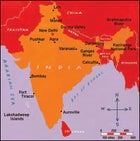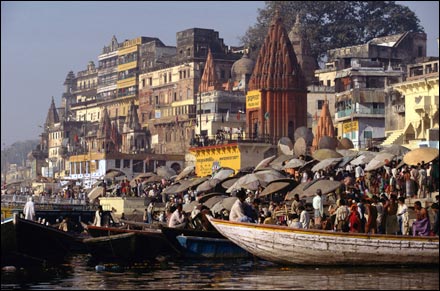WHY INDIA? After working and sweating for three months in a village in the southern Indian state of Tamil Nadu, I decided to head north for a break. I checked in to a remote guesthouse in the rugged Aravalli Mountains of eastern Rajasthan, where I gorged on fiery curries, fresh vegetables, and chewy parathas, all served on dinnerware made from banana leaves stitched together with thorns. At night, I spread out on the rooftop to sleep. There was no crushing density of bodies, no old men crapping in the street, no tinny loudspeakers screeching Indian show tunes. Instead I stared at the stars while kingfishers settled into the mango trees. Paradise. Except it was 110 degrees at 2 a.m., and I had worms.
The Joy of Chaos
The top ten adventures on the subcontinentIndia

Travel in India isn’t always easy. Nowhere else is the choreography of humanity and nature more passionate, bewildering, sensorial, and in-your-face extreme. “In India, the easiest and most necessary thing to ignore was the obvious,” wrote Nobel Prize winner V. S. Naipaul on surviving the difficulties of traveling in such an overloaded place. But it is precisely this blaring cacophony┬Śthe technicolor saris drying against clay hills, the sticky aroma of hot fried curry, the insistence of haggling shop owners┬Śthat draws travelers, leaving an indelible, soul-rankling impression. And the appeal is on the rise: India’s Ministry of Tourism reports that 3.3 million foreigners visited the country in 2004┬Śan increase of 24 percent over the previous year.
On the surface, the lure is obvious. The country is a stuffed geography, from the glacial flanks of 28,169-foot Kanchenjunga┬Śhighest in the nation, third-tallest in the world┬Śto the overgrown, jungly backwaters snaking through Kerala. This 1.2-million-square-mile landscape is home to 89 national parks and nearly 90,000 species of animals┬Śincluding sloth bears, flying lizards, leopards, rhinos, and every variety of monkey.
The country’s true richness, however, comes from its rapidly changing populace┬Śnow bloated to more than one billion. In the chaos of a sultry gray morning in Chennai, I heard at least a dozen languages in the train station, passed a handful of religious rituals on my way to market, and paid a mahout five rupees for his elephant to bless me with a trunk tap on the head. Later that day in the market, I met a man, Edwin Pudatha, who held the Guinness world record for “sitting and standing,” which he earned by going from sitting to standing 4,150 times in one hour. India, it turns out, has the lowest rate of Olympic-medal winners per capita but the highest percentage of Guinness world-record holders. “People aren’t that famous in the Olympics,” Pudatha explained, noting that his stunt was a regional media event and cause for monthlong parties in his village. “Now, I am known.”
India was once a place for smacking head-on into an unchanged heritage; now it’s a curious mix of caste-free middle-class technophiles, high-fashion elite, and entrepreneurs swooning in free-market bliss. You can easily find yourself sharing a plane ride with a software engineer from Hyderabad (known as Cyberabad) or a professor who just rapped with Bill Clinton about watershed management at the Aspen Institute. Across the globe, the permeation of Bollywood, masala dosas, and curly-toed Rajasthani slippers into Western society has helped fuel international interest in the subcontinent.
And travel to India has never been easier. In the past few years, the country has erupted with sparkling five-star hotels, all-inclusive spa resorts, and air-conditioned tour buses. The recent deregulation of the Indian airline industry has given rise to carriers with names like Air Sahara, SpiceJet, and┬Śmy favorite┬ŚKingfisher Airlines, which offers deeply discounted cross-country shuttles that allow travelers to curtail the grueling long-haul train trips. The Indian government has also relaxed restrictions on international investment, inspiring developers like Alfred Ford┬Śof Henry Ford lineage┬Śto break ground on a $500 million Vail-style ski resort in Himachal Pradesh and encouraging cruise lines to add Mumbai, Kerala, and Goa itineraries.
“These days, travelers to India are on a quest for experience,” explains Pamela Lassers, of tour operator Abercrombie & Kent, which has seen a 55 percent jump in India bookings. This is largely due, she says, to the sudden ease in negotiating the country’s famously rugged byways and improvements in domestic air service, as well as the growing availability of guides┬ŚA&K has just opened its second India-based office, in Jaipur; Mountain Travel Sobek leads trips from Rajasthan to the high mountain passes of Sikkim; and veteran operator Cox & Kings still offers more guided excursions than any other company.
Of course, a “guided tour” here is anything but predictable. On a visit to the cool, lush hill station of Kodaikanal, I hired a guide for what was to have been a simple stroll through the woods. A bearded naturalist with a walking stick, hiking boots, and a checked flannel shirt, Arjun became something of an Odyssean guide, leading me five miles up a faint trail to the wooden cabin of a Rastafarian Indian artist, across mossy vistas to the hobbitlike mud-and-dung wattle home of a British ex-schoolteacher, and finally through a grove of banyan trees knitted into a tunnel of living wood. Here we happened upon a grizzled sadhu (ascetic), who slipped Arjun a fat joint as a thank-you for mailing a package for him. “A High Times reporter was my last American client,” Arjun explained sheepishly, wagging his head.
India absorbs all these influences without compromising its mystique. Varanasi pilgrimages and marriages are arranged online, but temples in Kalimpong are lit exclusively by candles. A mega-interstate now stripes the desert plains of Karnataka and Tamil Nadu, but drivers go the wrong direction when they feel like it. The country still has tigers, camels, the Himalayas, the paratha wallah on the corner, fresh coconuts and mangoes falling off the trees, sadhus on hiking trails┬Śand the mystery of how all of it functions with such erratic, spectacular success. “Well,” as Mahatma Gandhi said, “India is a country of nonsense.” And that is exactly why you go.


